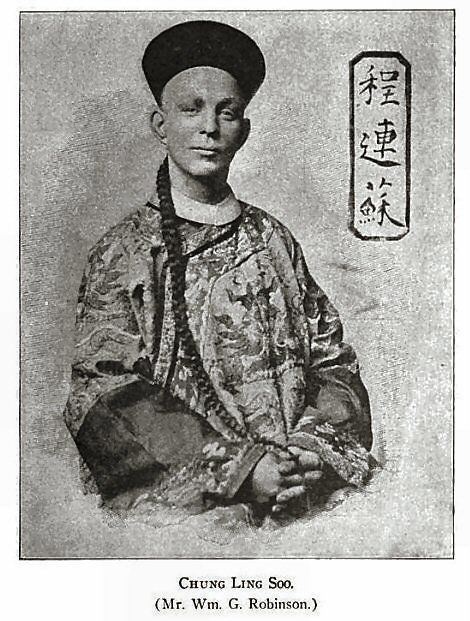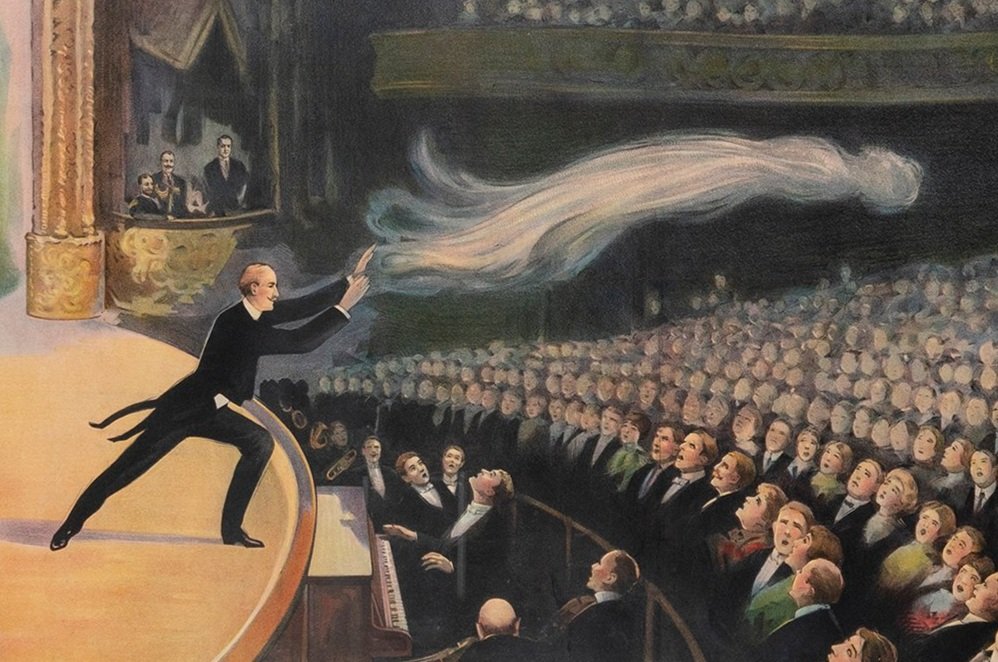The elusive American
By William Pack | Magician, Historian, and Educator, https://libraryprogramming.com/
By Thurston, John H. (John Henry), 1852-, photographer - Library of CongressCatalog: https://lccn.loc.gov/2015650990
Harry Houdini
(Ehrich Weiss / Erik Weisz)
B. March 24, 1874 – D. October 31, 1926
Mayer Samuel Weisz left his family in the recently combined towns of Buda-Pest in 1876 and sailed to America. He found a job in Appleton, Wisconsin, as the rabbi of the Zion Reform Jewish Congregation. Two years later, his wife Cecilia and his five sons, including Ehrich, immigrated to America.
Appleton was an idyllic child’s playground and young Ehrich took advantage of it. He began to show remarkable talents as an athlete and a love of show business. It is here where he may have seen his first circus and found his first hero, a tightrope walker. Ever resourceful, Ehrich scrounged up enough rope, tied it between two trees, and suffered the rope despite many bone-jarring falls until he walked it.
He was a freakishly great athlete at a young age. Later, he would be a champion runner, boxer, swimmer, and an exemplar of physical culture (Weightlifting and exercise). He could hold his breath at a world-record pace.
Those joys of Appleton would be short-lived. By 1883, just as the years of Rabbi Weiss’ hard work was to pay off with the building of a synagogue, he was dismissed. They ended up in Milwaukee, which was the worst time of their lives, constantly moving to stay ahead of the rent collectors and pawning religious books to buy meals.
About the age of nine or ten, Ehrich ran away from home to make his way in the world. It was a vastly different time, and children were treated more like little adults. They worked all types of jobs: shoeshine, paper boy, messenger boy, and even factory jobs. Ehrich worked all those jobs.
Then, his family moved to New York, and he joined them, working in a factory cutting men’s neckties in the garment district. It was during this time he saw his first magic trick. With a friend, Jacob Hyman, he began learning all the magic he could.
He began calling himself "Harry Houdini" after the French magician Jean-Eugène Robert-Houdin, after reading Robert-Houdin's autobiography in 1890. Hyman incorrectly believed that an “I” at the end of a name meant "like" in French. The two would perform as “The Brothers Houdini.”
He began calling himself "Harry Houdini"
after the French magician Jean-Eugène Robert-Houdin,
after reading Robert Houdin's autobiography in 1890.
Houdini began his magic career in 1891 but had little success. He performed in dime museums and sideshows and even doubled as "The Wild Man" at a circus. Houdini initially focused on traditional card tricks. At one point, he billed himself as the "King of Cards".
In the early 1890s, Houdini’s brother "Dash" (Theodore) replaced Hyman in “The Brothers Houdini.” During this time, they created one of magic’s greatest tricks, “The Metamorphosis,” a transposition of the two magicians from a locked steamer trunk.
In 1894, Houdini met Wilhelmina Beatrice "Bess" Rahner on Coney Island. Dash actually saw her first, but Houdini always got his way. Two weeks after meeting her, he married her. Bess replaced Dash in the act, which became known as "The Houdinis," and for the rest of Houdini's performing career, Bess worked as his stage assistant. Within a few years, a successful Houdini would launch Dash’s magic career by building him a duplicate act and renaming him “Hardeen.”
The Houdinis, Harry, Bessie introducing the only and original. [approximately 1895]. Houdini's big break came in 1899 when he met manager Martin Beck in St. Paul, Minnesota. He was impressed by Houdini's Challenge Handcuff Act, in which he challenged his audience to bring any handcuff to the theater, and he would escape from them. The Challenge Handcuff Act changes everything for Houdini. Beck booked him on the western Orpheum vaudeville circuit. Within months, he was performing at the top vaudeville houses in the country. His salary rose from $60 to $90 to $125 to $400 weekly.
But when he returned east, the audiences were not as enthusiastic about him, and his career took a downturn. Discouraged, Houdini sailed to Europe. Houdini's British agent, Harry Day, helped him to get an interview with C. Dundas Slater, then manager of the Alhambra Theatre. He was challenged to escape from the handcuffs at Scotland Yard. He succeeded in baffling the police so effectively that he was booked at the Alhambra for six months. His show was an immediate hit.
Between 1900 and 1920, he appeared in theatres all over Great Britain, breaking all box office records. He also toured the Netherlands, Germany, France, and Russia and became widely known as "The Handcuff King". In each city, Houdini challenged local police to restrain him with shackles and lock him in their jails. In many of these challenges, he was first stripped nude and searched. He freed himself from jails, handcuffs, chains, ropes, and straitjackets, often while hanging from a rope off the side of a building, thirteen stories in the air.
In each city, Houdini challenged local police to restrain him
with shackles and lock him in their jails.
In many of these challenges,
he was first stripped nude and searched.
Because of his many imitators, Houdini put his "handcuff act" behind him and began escaping from a locked, water-filled milk can. The possibility of failure and a drowning death thrilled his audiences. Houdini also invited the public to devise contraptions to restrain him. These included wooden packing crates, riveted boilers, wet sheets, mail bags, a glass box, paper bags, and more. He escaped every one, to the befuddlement of those who constructed those challenges.
Houdini introduced the Chinese Water Torture Cell at the Circus Busch in Berlin, Germany, on September 21, 1912. He was suspended upside-down in a locked glass-and-steel cabinet overflowing with water, holding his breath for more than three minutes. He tried to take it out of the act many times but had to put it back in because it was so popular.
For most of his career, Houdini was a headline act in Vaudeville doing thirty-minute turns. One of Houdini's most notable non-escape stage illusions was performed at the New York Hippodrome when he vanished a full-grown elephant from the stage. In the last couple of years, he performed a whole evening show that was three parts, with two intermissions, lasting 2 ½ hours.
In the 1920s, Houdini turned his energies toward debunking psychics and mediums to show how they were taking advantage of the emotionally vulnerable bereaved. Houdini's training in magic allowed him to expose frauds who had successfully fooled many scientists and academics. He was a member of a Scientific American committee that offered a cash prize to any medium who could successfully demonstrate supernatural abilities. None were able to do so, and the prize was never collected.
Houdini died on October 31, 1926, at the age of 52, from peritonitis (swelling of the abdomen) related to appendicitis and possibly related to punches to his abdomen he had received days earlier. Houdini's funeral was held on November 4, 1926, in New York, with more than 2,000 mourners in attendance.



